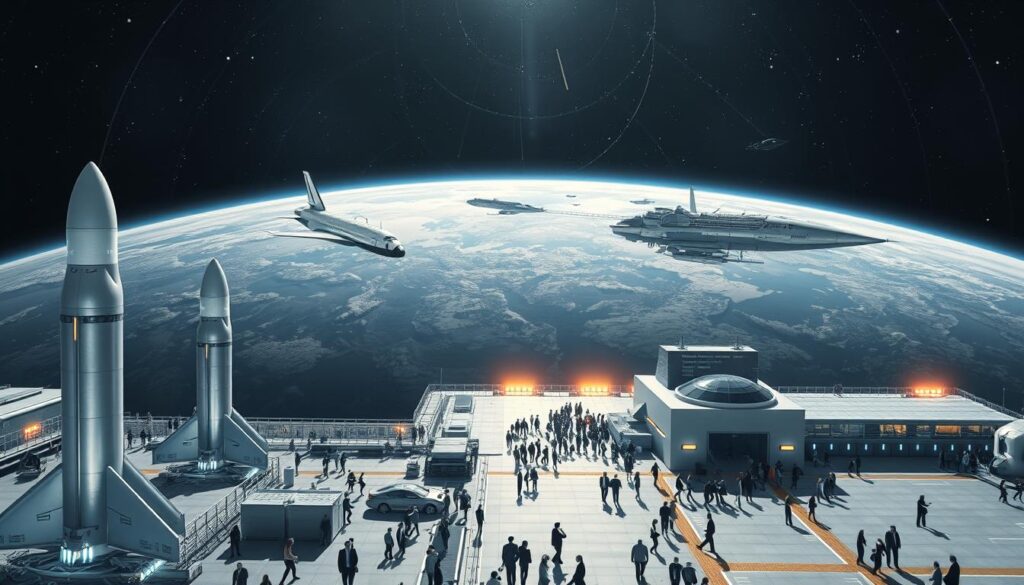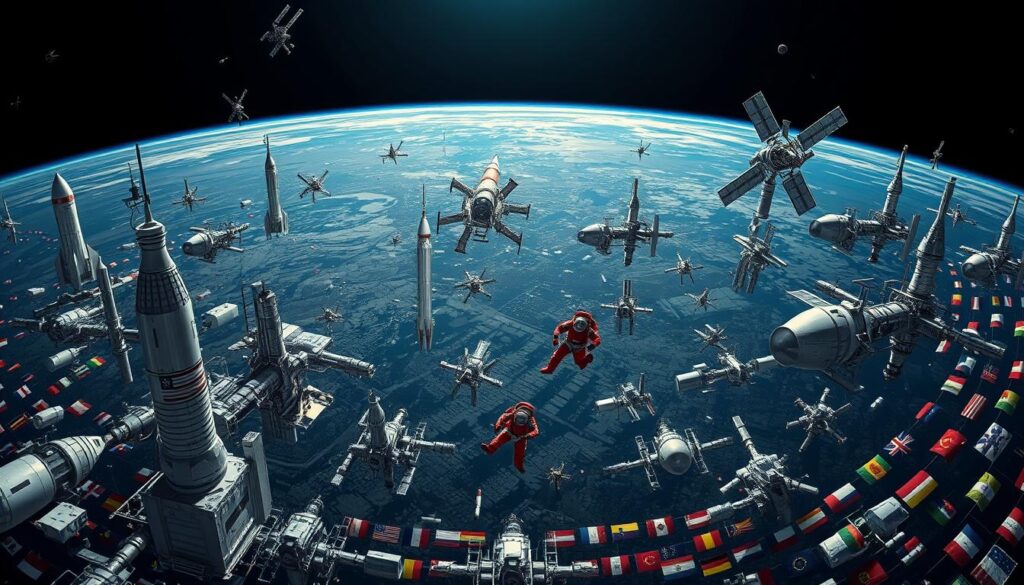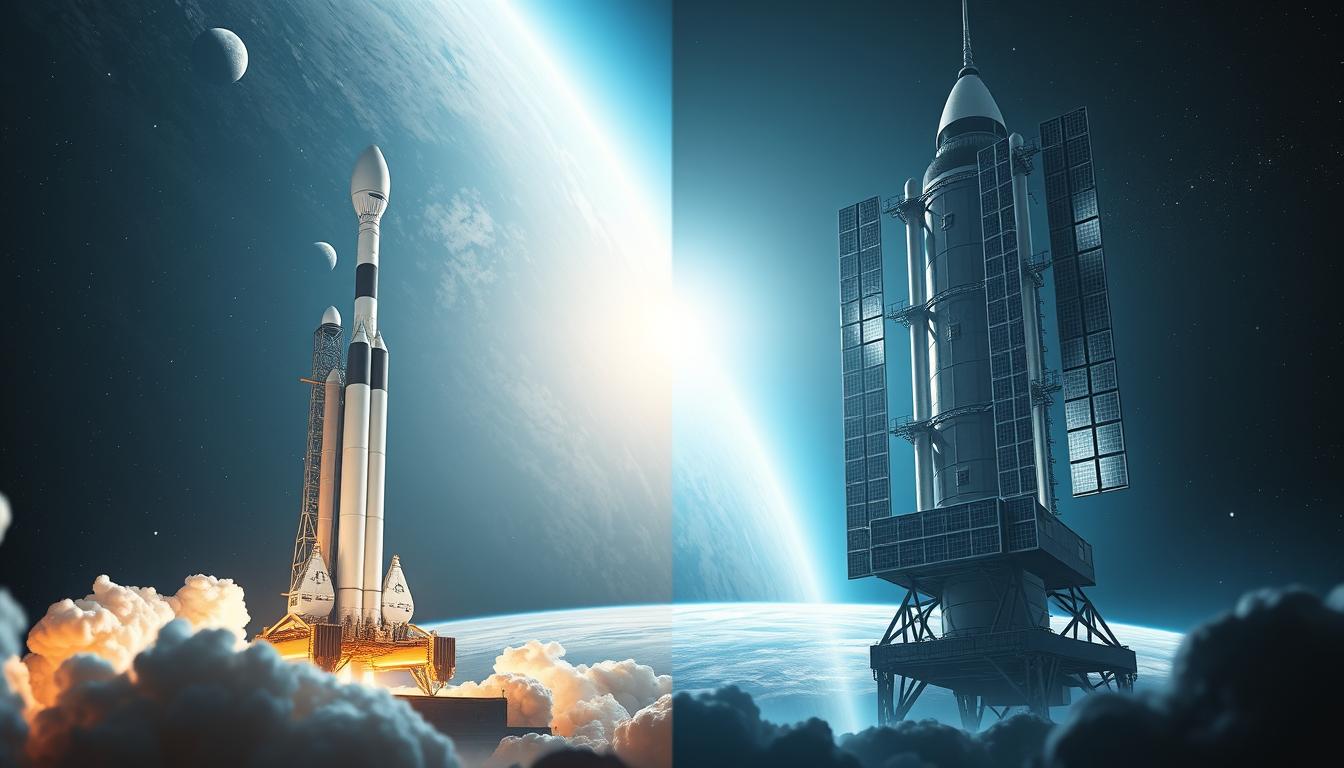The space technology race between India and China is getting fiercer. Both countries are making big moves in space exploration. They’ve been pouring a lot of money into their space programs, pushing the limits of space travel.
Looking into space technology, it’s clear that the rivalry between India’s space program and China’s space exploration is more than just reaching goals. It’s about showing off their tech skills to the world.
Key Takeaways
- India and China are emerging as major players in the global space technology landscape.
- Both countries have made significant investments in their space programs.
- The competition between India and China is driving innovation in space exploration.
- Space technology comparison between the two nations reveals interesting insights.
- The future of space exploration is likely to be shaped by these two Asian giants.
The Space Race Between Asian Giants
A new era of competition has started in space technology between India and China. These two Asian giants are leading the way with their space programs. The Indian Space Research Organization (ISRO) and the China National Space Administration (CNSA) are pushing the limits of what’s possible.
This competition is not just about reaching milestones. It’s about showing off their technological skills. India’s space program is known for being cost-effective and creative. China’s space endeavors have seen fast progress and big investments.
ISRO and CNSA have different ways to reach their goals. ISRO is famous for its low-budget Mars Orbiter Mission. CNSA, on the other hand, is expanding fast, including lunar missions and a space station.
This comparison shows the strengths of each nation’s space program. As they keep improving, the world waits with excitement. The results of this race will impact technology, economy, and politics worldwide.
The rivalry between ISRO and CNSA will lead to more space technology innovations. These advancements will benefit not just these countries but the whole world. Looking ahead, the space race between India and China will shape our technological future.
Historical Development of Space Programs
The space race between India and China is heating up. It’s important to know how their space programs have grown. Both countries have made big leaps in space exploration, turning their space agencies into powerful forces.
India’s Space Journey: From Humble Beginnings to ISRO
India’s space journey started small, with the Indian National Committee for Space Research (INCOSPAR) in 1962. It grew into the Indian Space Research Organization (ISRO) in 1969. Despite early challenges and limited funds, ISRO reached a big milestone with the launch of Rohini-1 in 1975.
The PSLV (Polar Satellite Launch Vehicle) and GSLV (Geosynchronous Satellite Launch Vehicle) programs helped India become a trusted launch provider. ISRO’s affordable launch services and successful satellite missions have made it famous worldwide. These achievements show India’s growing space ambitions.
China’s Space Evolution: The Rise of CNSA
China’s space program, run by the China National Space Administration (CNSA), has grown fast. The launch of Dong Fang Hong 1 in 1970 was China’s first step into space. The 1990s saw a big increase in China’s space efforts, with the Long March rocket series.
CNSA has achieved great things, like landing on the moon’s far side with the Chang’e 4 mission. China’s space program focuses on both science and technology. Expect China to keep pushing the limits of space technology.
Launch Capabilities and Rocket Technology
Launch capabilities and rocket technology are key in India and China’s space programs. They show how these countries aim to reach space. Knowing about their launch tech gives us insight into their space goals and successes.
India’s PSLV and GSLV Programs
India’s space program has grown thanks to the PSLV and GSLV. The PSLV is known for launching satellites into polar orbits well. The GSLV handles heavier payloads and orbits.
Cost-effectiveness and Reliability
The PSLV is known for being affordable and reliable. It’s often chosen for satellite launches. It can also launch many satellites at once, which is a big plus.
Recent Advancements and Challenges
The GSLV program has seen big improvements, like more powerful upper stages. But, India faces challenges like keeping a steady launch schedule and boosting success rates.
China’s Long March Rocket Family
China’s space launches rely on the Long March rockets. The Long March 5 is a powerful rocket for heavy payloads.
Technical Capabilities and Evolution
The Long March rockets have grown in payload capacity and reliability. Their technical advancements are key for China’s ambitious space missions.
New Generation Launch Vehicles
China is working on new launch vehicles, like the Long March 9. These will boost its launch abilities for more complex missions.
Comparative Launch Success Rates and Payload Capacity
India and China have both improved in launch success and payload capacity. India’s PSLV has a high success rate. China’s Long March rockets are versatile for various payloads.
China launches more often and can carry heavier payloads, showing its bigger space program. But, India’s cost-effectiveness and reliable launch vehicles are strong points.
Satellite Technology and Earth Observation
India and China are leading in satellite technology and earth observation. They are making a big leap in using space for communication, navigation, and observing the Earth.
India’s Remote Sensing and Communication Satellites
India has made big steps in remote sensing and communication satellites. The Indian National Satellite System (INSAT) and the Geosynchronous Satellite Launch Vehicle (GSLV) have been key to this progress.
INSAT and GSAT Series
The INSAT series is a key part of India’s communication satellites. It helps with TV broadcasting, telecommunications, and weather forecasting. The GSAT series has also boosted India’s telecom and broadcasting abilities. These satellites have greatly improved India’s communication setup.
| Satellite Series | Purpose | Notable Features |
|---|---|---|
| INSAT | Communication, Weather Forecasting | Multi-purpose satellite system |
| GSAT | Telecommunications, Broadcasting | Enhanced communication capabilities |
Cartosat and ResourceSat Achievements
India’s Cartosat and ResourceSat series are key in earth observation. Cartosat offers high-resolution images for maps, while ResourceSat helps manage natural resources. These satellites help India manage its natural resources better.
China’s Satellite Networks and Global Coverage
China has also advanced in satellite technology, focusing on global coverage and satellite networks.
BeiDou Navigation System
The BeiDou Navigation System is China’s GPS alternative, providing navigation and timing services. It’s vital for both civilian and military uses, giving accurate location and timing.
Gaofen and Yaogan Earth Observation Systems
China’s Gaofen and Yaogan series are for earth observation. Gaofen satellites offer high-resolution images for environmental monitoring and disaster management. Yaogan satellites are for remote sensing, helping in both military and civilian space programs.
| Satellite Series | Purpose | Notable Features |
|---|---|---|
| BeiDou | Navigation, Timing | Global coverage, high precision |
| Gaofen | Earth Observation, Environmental Monitoring | High-resolution imagery |
| Yaogan | Remote Sensing | Military and civilian applications |
Is India Way Ahead of China in Space Technology? A Critical Analysis
The space race between India and China is heating up. A key question is: Is India ahead in space technology? The answer depends on comparing their achievements, tech advancements, and strategies.
Areas Where India Leads
India has made big strides in space tech, focusing on cost-effective missions and new tech.
Cost-efficient Mission Planning
ISRO, India’s space agency, is known for its smart budgeting. For example, the Mangalyaan mission to Mars was very cheap. This cost-saving is a big plus, letting India do more with less.
Specific Technological Innovations
India has also led in tech like the PSLV (Polar Satellite Launch Vehicle). It’s a key tool for launching satellites. Plus, India’s work on cryogenic engines has made it a strong player in launch services.
- Successful deployment of numerous satellites
- Advancements in launch vehicle technology
- Cost-effective mission design
Areas Where China Dominates
China also shines in space tech, mainly in the size of its space program and human spaceflight.
Scale of Operations
China’s space program has grown fast, with more launches and a big space infrastructure. The Long March rocket series has helped China tackle big projects.
Human Spaceflight Capabilities
China has also made big strides in sending humans to space. The Tiangong Space Station shows its skill. China can keep people in space for a long time and do complex tasks.
“China’s space program has made tremendous progress in the past two decades, with significant advancements in launch capabilities, space stations, and lunar exploration.” –
In summary, India excels in some areas like budget-friendly missions and new tech. But China leads in the size of its space program and human spaceflight. The debate on who’s ahead in space tech is complex. It depends on what you look at.
Space Stations and Human Spaceflight
India and China are racing ahead in space technology, focusing on space stations and human spaceflight. They’ve made big strides in their space programs.
India’s Gaganyaan Program
India is diving into human spaceflight with the Gaganyaan program. This project shows India’s growing skills in space tech.
Current Status and Challenges
The Gaganyaan program is in development, with many tests done to ensure safety. A big challenge is creating a reliable crew escape system.
ISRO is working hard to solve these problems. They plan to do unmanned missions first, then manned ones.
Future Plans and Potentials
Once it succeeds, India aims to grow its space station work. They might team up with other countries for more progress. The Gaganyaan program is a big step for India’s space goals.
China’s Tiangong Space Station
China has made big leaps with its Tiangong Space Station. It shows China’s advanced space skills. The Tiangong Space Station is a key win for China’s space program.
Operational Capabilities
The Tiangong Space Station is up and running, hosting astronauts for long times. It proves China’s skill in long space missions.
Scientific Research and Achievements
The Tiangong Space Station has helped with many scientific studies. It has given valuable data to science. China’s space research shows it’s a leading space nation.
| Program | Current Status | Future Plans |
|---|---|---|
| Gaganyaan | Development phase | Unmanned missions followed by manned flights |
| Tiangong Space Station | Fully operational | Continued scientific research and possible growth |
Lunar and Planetary Exploration
India and China are leading the way in space exploration. They are making big strides in studying the Moon and other planets. Their work is adding important data to science worldwide.
India’s Chandrayaan and Mars Orbiter Missions
India’s space program has hit many high points. The Chandrayaan missions have greatly helped us understand the Moon.
Chandrayaan’s Lunar Discoveries
The Chandrayaan-1 mission was a big win for India in 2008. It found water on the Moon, a big deal for future missions. Chandrayaan-2, launched in 2019, brought even more knowledge with its Vikram lander and Pragyan rover.
India’s Mars Orbiter Mission (Mangalyaan) in 2013 was a huge achievement. It made India the fourth to reach Mars. The mission gave us insights into Martian geology and climate.
China’s Chang’e and Tianwen Programs
China is also making big moves in space with its Chang’e and Tianwen programs. These missions show China’s growing space skills.
Lunar Sample Return Achievements
The Chang’e program has been key for China’s Moon missions. Chang’e 4 landed on the Moon’s far side, a first. Chang’e 5 brought back Moon samples, a big tech win.
Mars and Asteroid Exploration Plans
China’s Tianwen-1 mission has been studying Mars with an orbiter, lander, and rover. It started in 2021. China plans to explore asteroids and other planets too, expanding its space reach.
| Mission | Launch Year | Key Achievements |
|---|---|---|
| Chandrayaan-1 | 2008 | Discovery of water molecules on the Moon |
| Mars Orbiter Mission | 2013 | Successful orbit of Mars |
| Chang’e 4 | 2019 | First landing on the far side of the Moon |
| Chang’e 5 | 2020 | Lunar sample return |
| Tianwen-1 | 2020 | Mars orbiter, lander, and rover mission |
Indigenous Technology Development
India and China are leading the way in space technology. They focus on making their own tech to be more self-reliant. This drive for innovation is key to their space program success.
India’s Self-Reliance in Space Technology
India has made big steps in space tech. The Indian Space Research Organisation (ISRO) has led the way. They’ve made launch vehicles, satellites, and more on their own.
ISRO’s work has cut down on foreign tech use. It has also grown a strong domestic space industry. For example, the PSLV and GSLV have helped India launch satellites. This has boosted its space abilities.
China’s Domestic Innovation Ecosystem
China is also pushing hard in space tech. The China National Space Administration (CNSA) is leading this push. They’re improving launch tech, satellites, and space exploration.
China’s focus on making its own tech has made it a big name in space. The Long March rockets show China’s skill in launch tech.
| Aspect | India | China |
|---|---|---|
| Launch Vehicles | PSLV, GSLV | Long March |
| Satellite Development | IRNSS, RISAT | Beidou Navigation System |
| Space Exploration | Chandrayaan, Mangalyaan | Chang’e, Tianwen |
Commercial Space Ventures
Commercial space ventures are changing how we explore and use space. The private space sector is key in making space travel cheaper and more innovative. India and China are leading the way in this exciting field.

Private Space Sector Growth in India
India’s private space sector is growing fast. Startups like Skylark Labs and AgniKul Cosmos are creating new launch and satellite tech. The government is helping by supporting private investment.
This growth makes India’s space industry more competitive. It could have a big impact worldwide.
China’s Commercial Launch Providers
China is also seeing growth in commercial launch providers. Companies like OneSpace and LandSpace are working on advanced rockets. They aim to compete globally.
China’s strong space infrastructure and government support help these companies. Their success could make China a major player in the commercial space market.
Military and Strategic Space Capabilities
The space race between India and China is heating up. Space technology’s military and strategic value is growing. Both countries see space as key in modern warfare and are spending a lot on their space programs.
India’s Defense Space Applications
India is improving its defense space tech. It’s focusing on better surveillance and security. A big step was its anti-satellite testing success in 2019. This made India one of the few to achieve this.
Anti-Satellite Testing
India’s test showed it can destroy satellites in space. This skill is vital for modern warfare. Space-based assets are now a big part of military strategy.
Surveillance and Security Systems
India is also working on advanced surveillance and security systems. It’s using space to boost national security. These systems help India watch its borders and seas better.
China’s Military Space Program
China’s military space program is a big part of its space strategy. It’s investing a lot in space-based military assets. China’s military space efforts cover many areas.
Space-Based Military Assets
China is growing its space-based military assets. This includes spy satellites and navigation systems. These assets give China better surveillance and navigation data for its military.
Counter-Space Capabilities
China is also working on counter-space capabilities. This includes anti-satellite missiles. These are meant to take out the space assets of other countries.
India and China’s focus on military space shows how important space is for national security. As they keep investing in space, the impact on global security will be big.
Budget and Resource Allocation
Budget and resource allocation are key in the space race between India and China. Both countries aim to reach their space goals with the right financial support and resource planning.
India’s Space Budget and Cost-Effectiveness
India’s space program is known for being cost-effective. The Indian Space Research Organisation (ISRO) has achieved great things at a lower cost than other countries. For example, the Mangalyaan mission to Mars cost just around $74 million.
ISRO’s budget has grown, showing India’s dedication to space. It’s not just about the amount of money. It’s also about using it wisely. ISRO’s success in managing its budget shows its efficiency.
| Year | ISRO Budget (in million USD) | Major Achievements |
|---|---|---|
| 2018 | 1,500 | Successful launch of Chandrayaan-1 |
| 2020 | 1,800 | Launch of Gaganyaan (manned mission) preparations |
| 2022 | 2,000 | Enhanced focus on satellite technology and Earth observation |
China’s Space Funding and Investment
China’s space program, led by the China National Space Administration (CNSA), has seen a lot of investment. China’s space funding is not as open as India’s, but it’s clear they’re spending a lot to advance in space technology.
China’s space budget is thought to be much higher than India’s. This extra funding has allowed CNSA to take on big projects like the Tiangong Space Station and lunar missions.
China’s space program isn’t just funded by the government. Private companies and state-owned enterprises are also involved. They help develop space technologies and infrastructure.
International Collaborations and Partnerships
The space race between India and China is heating up. Both countries see the importance of working together. They believe global alliances are key to advancing their space programs.
India’s Space Diplomacy
India is teaming up with other countries to boost its space tech. It’s focusing on partnerships with top space agencies.
NASA and ESA Partnerships
India’s work with NASA and ESA is notable. For example, NASA helped with India’s Mangalyaan mission. This shows how teamwork can help in space exploration.
Regional Cooperation Initiatives
India is also working on regional projects. The South Asia Satellite (SAS-6) aims to improve connectivity and cooperation. This shows India’s dedication to using space for regional growth.
| Partnership | Description | Year |
|---|---|---|
| ISRO-NASA Collaboration | Support for Mangalyaan Mission | 2013 |
| ISRO-ESA Cooperation | Joint Earth Observation Missions | 2017 |
| SAS-6 Project | Regional Connectivity Initiative | 2016 |
China’s Global Space Alliances
China is growing its space influence through alliances. Its Belt and Road Initiative (BRI) includes a space component.
Belt and Road Space Information Corridor
The Belt and Road Space Information Corridor is part of China’s BRI. It aims to improve connectivity with space-based infrastructure. This move is expected to increase China’s role in global space.
Partnerships with Russia and Emerging Space Nations
China is also strengthening ties with Russia and other space nations. These partnerships are key for future space exploration. They will shape the future of space travel.

Future Space Ambitions
The next decade is going to be exciting for space exploration. India and China are leading the way with new ideas. Their plans will shape the future of space for everyone.
India’s Vision for the Next Decade
India is ready to make big moves in space. It aims to improve its satellite tech and send missions to the Moon and Mars. ISRO’s future roadmap includes a space station, better launch systems, and working with other countries.
India wants to use its own tech to grow its space program. This will make it a big player in the space world.
The government is also helping private companies in space. This will bring new ideas and growth to the field.
China’s Long-term Space Strategy
China plans to be a big player in space. It wants to grow its Tiangong Space Station and explore the Moon and planets. China’s National Space Administration (CNSA) is working on a space network and solar power systems.
China is focusing on new tech and working with others. It plans to send people to the Moon and set up a lunar research station. This will be a big step for China in space.
Conclusion: The Ongoing Asian Space Race
The space race between India and China is fierce. Both countries have made big steps forward. But, is India really ahead of China in space tech? It depends on how you look at their achievements.
India’s ISRO has been great at launching satellites at low cost. They’ve done well with PSLV and GSLV. On the other hand, China’s CNSA has shown off with Long March rockets and the Tiangong space station. Both have also improved in satellite tech, moon missions, and space business.
This space race will keep pushing tech forward. India and China’s rivalry will help everyone in space. We’ll see more teamwork, better launch tech, and more money for space projects.
FAQ
Is India ahead of China in space technology?
India and China are both leaders in space technology, but in different ways. India excels in planning missions that are cost-effective and has made some unique technological breakthroughs. On the other hand, China has a bigger scale of operations and has made great strides in human spaceflight.
What are the key achievements of ISRO and CNSA?
ISRO has made many important achievements, like launching the PSLV and GSLV rockets successfully. They’ve also had big wins with missions like Chandrayaan and the Mars Orbiter. CNSA has also achieved a lot, including launching the Tiangong Space Station and the Chang’e lunar program. They’ve also developed the BeiDou Navigation System.
How do India’s and China’s launch capabilities compare?
India has reliable launch vehicles like the PSLV and GSLV. China, on the other hand, has a wider range of launch vehicles, including the Long March rockets. China launches more often and can carry heavier payloads than India.
What are the future plans for India’s Gaganyaan program?
India’s Gaganyaan program aims to send astronauts to space soon. Despite some delays, ISRO is working hard to meet this goal. This would be a big step for India in human spaceflight.
How does China’s Tiangong Space Station compare to other space stations?
China’s Tiangong Space Station is a major achievement, showing their skills in space station operations and research. It’s compared to the International Space Station in terms of its capabilities and research scope.
What are the implications of India’s and China’s space advancements for the global space economy?
India and China’s space tech advancements are big for the global space economy. They’re helping grow the commercial space sector. Their innovations are making space more accessible and cheaper.
How do India and China collaborate internationally in space exploration?
India works with space agencies like NASA and ESA, and joins regional efforts. China has formed global alliances, like the Belt and Road Space Information Corridor. They also partner with countries like Russia in space exploration.
What are the budget allocations for India’s and China’s space programs?
India’s space budget is much lower than China’s. Despite this, India has been cost-effective in its space missions. China’s bigger budget has allowed them to take on more complex projects.
What are the military implications of India’s and China’s space capabilities?
Both India and China have military space capabilities, like surveillance and security systems. They’ve also tested anti-satellite systems. These capabilities are important for regional and global security.




